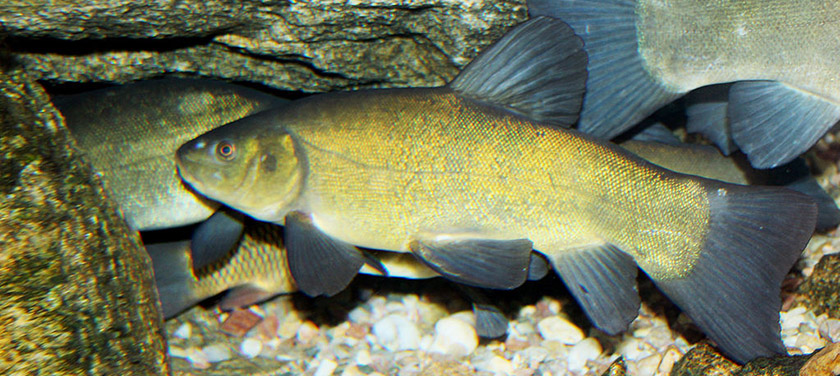Tench can live anywhere and will eat anything. And that’s the problem

Tench – good eating, not so good neighbor. Photo: Karelj, Creative Commons, some rights reserved
You wouldn’t think minnows, which seem like benign 1:200 scale models of real fish, would garner complaints. How much trouble can a minnow cause?
Potentially a lot, if it’s real big and has an enormous tribe. It may be a card-carrying member of the minnow family, but the invasive tench (Tinca tinca) can grow to 18 inches long and weigh as much as three pounds. In addition, it has a voracious appetite and will literally eat any organic matter. As for numbers, experts disagree, but at minimum a female will lay around 200,000 eggs a year, possibly as many as 900,000.
Tench are native to most of Europe, including the British Isles and Nordic countries, and to parts of southwestern Asia as well, but are now present on every continent save Antarctica. Some invasive species need to stow away in pallet wood to get here, but tench were intentionally brought in. As early as 1883, the United States Bureau of Fisheries started shipping them here as a fish farm species.
Experienced anglers will probably find it easier to identify this invader, which when small can look like a native minnow species. With a deep but thin body, mature tench could be mistaken for a panfish such as rock bass. From above they typically look green, ranging from olive to very dark; this transitions to gold on the sides and belly. They have black fins, rather small red-orange eyes, and tiny scales embedded in an unusually thick film of mucus. For those who don’t want to evaluate mucus layers, look for two small barbels (“whiskers”) one on either side of the upper jaw.
They are now established in 38 states, including New York, which has recently identified tench in the Great Chazy River (2008) and Lake Champlain (2002). In Canada they are in British Columbia and also Quebec, where a new hybrid escaped from an unlicensed fish farm in 1986 into the Richelieu River and eventually the St. Lawrence. To date we know it has reached Montreal, and may have traveled farther. It is the Quebec hybrid strain which currently threatens the Great Lakes and the upstream reaches of the St. Lawrence.
If tench are tasty and we farm-raise them in ponds, what’s the problem? One issue is that tench are tolerant to a fault. Except for whitewater conditions and marshes, they’re happy whether the water body is salt or fresh, flowing or static, clean or polluted, tropical or frigid, oxygenated or anoxic, and—get this—wet or dry (evidently they can survive in mud for several months—exact limit unknown—until a dry spell ends). And although they prefer snails and mollusks, tench will eat whatever, including rotting vegetation. They make carp and suckers look persnickety.
Being laid-back about what you eat and where you sleep is not necessarily a problem, as many college students will attest to. Bad habits are another matter. Fact: poor table manners may lead to reduced water quality.
Gregarious, boisterous diners, tench churn up bottom sediments which increases turbidity and releases nutrients from the mud. Tench also harbor parasites that can be transferred to native fish and mollusks. The copper redhorse (Moxostoma hubbsi) is said to be particularly vulnerable. Tench compete with indigenous fish such as perch, and have been associated with a decline of that species following their invasion of a body of water. Mollusks and crustaceans, organisms which consume algae, are preferentially grazed by tench to the point that algae blooms may occur more frequently post-infestation.
Not all invasive species are created equal. The Asian longhorn beetle seems like the project of an evil overlord; if it has one redeeming quality, no one has yet identified it. Tench, on the other hand, have some supporters. Easily raised under all kinds of conditions, they are an important food source, and are still cultivated around the world (including in one U.S. state). They are considered a decent sport fish in some locales, and are fodder for many native fish.
Information on tench is easy to find, but is sometimes inconsistent, even among reliable sources. Perhaps because of its equivocal character, widespread distribution and long history of domestication, the tench has not been studied as much as other aquatic invasives have.
Tench may not be as destructive as some invaders, and we may need to study it further, but we know it will cause some harm to the Great Lakes ecosystem, and we need to do all we can to exclude it for as long as possible.
Paul Hetzler is a horticulture and natural resources educator with Cornell Cooperative Extension of St. Lawrence County.
Tags: aquatic invasives, environment, fish, invasive species








So let’s eat ’em. How about a bit of advice from successful anglers and some favourite recipes.
I agree with MIke. Eat them out of existence before they eat up all of the other fish.
Why not start commercial harvest of them?